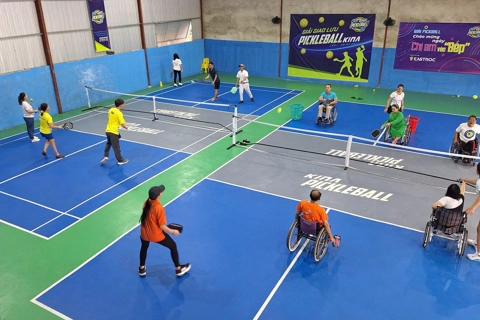Green infrastructure essential for Hanoi's urban resilience
Major cities in Vietnam are facing greater challenges from climate change, requiring drastic action to address the issues.
Experts said investment in green infrastructure in Vietnam's major cities, including Hanoi, has quickly become an urgent issue amid the severe impacts of climate change.
| Hoa Binh Park in Hanoi. Photo: Pham Hung |
The historical flooding in Danang on October 14, seen as the worst in the past 30 years by locals as the heavy rainfall almost inundated the entire city by up to 1.5 meters, remains a warning sign for other cities. The incident again raises the urgency for significant investment in essential infrastructure to help cities cope with extreme weather conditions and ensure a healthy living environment.
In addition to heavy downpours and extreme weather, experts have said the flooding laid bare the inadequate social and technical infrastructure in cities that have been concealed by the rapid urbanization rate.
A report by the Ministry of Construction on Vietnam's current progress in developing green urban infrastructure revealed that green space per capita in Vietnamese cities is only 2-3 square meters per person, while the UN minimum is 10 square meters and the world's modern cities 20-25 square meters.
Meanwhile, the total area of planned green space is only 70,000 hectares, or 1.2% of the urban building area, below the 10% for road, and the average is 20-26%.
Road density in Hanoi and Ho Chi Minh City is estimated at 2-4 kilometers per square kilometer, behind the 4-6 kilometer standard.
Many urban experts, therefore, called for promoting safe and sustainable green infrastructure development and consider this a critical part of urban planning, including a network of the technical infrastructure of transport, lighting, water provision, wastewater treatment, and social infrastructure of green and parks.
Vietnam currently has 870 urban cities with an urbanization rate of 40.5%, an increase of nearly 10% against 2010.
Drafting legal foundation
Data from Hanoi's Department of Construction acknowledged the city's shortcomings in green infrastructure development.
During the 2015-2020 period, the water surface area declined by 203.63 hectares as many lakes were used for land reclamation, not to mention illegal use of the water surface for business purposes.
In addition, agricultural land is also shrinking due to the rapid pace of urbanization, while no progress has been made in constructing new public spaces.
The agency also pointed out that the rising number of personal transport vehicles is putting pressure on transport infrastructure and a lack of plays for green vehicles in the planning, such as bicycles.
Chairman of the Vietnam Urban Planning and Development Association Tran Ngoc Chinh told The Hanoi Times of the need to improve the legal framework for lake and green space management, draft a specialized law on urban spaces, and address the inefficiency of green space management in cities.
Chinh expected the city to promote agricultural eco-tourism as a solution to protect cultural and historical values along with the natural landscape.
"The preservation of green space, in particular, would need greater public participation," he said.
Sharing Chinh's view, lecturer Le Thu Trang from the University of Construction called for Hanoi to draft a legal framework for green infrastructure to promote green growth.
"The planning, construction and maintenance of green infrastructure require the participation of various parties, especially local people," Trang told The Hanoi Times.
"Public consultation is the critical factor in finding consensus between authorities and people in developing green infrastructure, as well as ensuring the right direction for sustainable urban growth," she added.
"Green infrastructure development is the main solution for major cities to address issues that emerged from urbanization and climate change, especially flooding," Trang added.

.jpeg)









